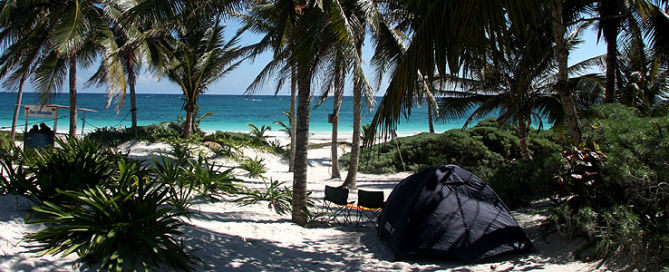Back in Mexico – Km 125,764
I arrived in Mexico City by plane from Miami, a few days before biciexpo 2013, where I was invited by the organizers to give talks about my trip. In exchange, I was able to have a kiosk to sell my documentary, and I sold very well in those days.

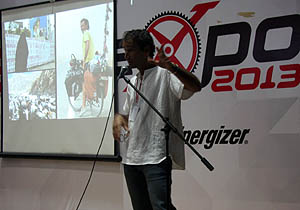
I wasn’t planning on going back to Mexico City, nor to fly there with 85 kg of luggage, which is expensive and gives me a headache, but the proposal was tempting not only because of the chance of talking with cycling enthusiasts, but because in the city awaited the special person who thought of me coming to this exhibit in the first place.
I met her in 2004, in my European tour, when I was financing my tour though cities selling photos of Africa. She purchased several, and started following my trip online. Nine years later, when I first arrived in Mexico, I met with this beautiful woman, who pampered me and fell in love with me. But, wanting to continue my trip, I left for the North. Four months later, I met with her again, and we’d go through a story fit for a soap opera.

“Mexico is by far the country of soap operas”, said my friend Tenoch. “We are the creators and revolutionaries of the soap opera. It is a religion that, after dinner time, housewives turn the TV on and sit to watch one. They have done laundry, the house errands, made dinner, and finished homework with the kids. At 7 pm, it’s a must. And it’s a tearful drama. But that’s how we Mexicans are. We dream of being uno of those soap opera characters where the poor girl who lives among streetlights is rescued by the rich man who owns a Factory, they fall in love and live happily. We like our soap operas. It’s hilarious, but sad at the same time, because politicians are using those soap operas, soccer and religious symbols as the Guadalupe Virgin to take us elsewhere. And so people lose touch with reality, but I don’t blame them. Many make 5 USD for a day of work. That’s why when they get home, the last thing they want to know is what such and such politician said; they want a beer, that Chicharito (Mexican soccer player in England) scores a goal, or to watch a soap opera.
The day I arrived to the airport she came to look for me in her fancy new silver truck. From then on, I stayed on the 17th floor where she lived, with a view to the city. I had a cook and chauffeur, and even a barber came to give me a haircut. As very few times during my trip, I lived among luxury and pleasure, and I fell in love with this beautiful Mexican woman who treated me like royalty. I lived that as a honeymoon, that lasted more than my stay in Mexico city, because we arranged to meet during the time I stayed in the country.
As my friend Tenoch would say, what I went through in Mexico was a real soap opera. What was harder was going back to my reality, the route, that nomadic life that only long-distance travelers know, the one that takes so much from you but gives back as well, and for that I choose it. Anyhow, as many other times, I wonder: Why do I leave if it’s so nice here?
Like this, divided like yin and yang, I toured the second part of Mexico, which has unexpectedly already marked my travels and my heart.
A reality that hurts
This time, my tour through Mexico took me to the states of Puebla, Veracruz, Tabasco, Chiapas, Campeche, Yucatán and Quintana Roo. During that month and a half I slept in simple hotels, fire stations or churches. At a small church in the Catazaja beach I learned of the immigrant house “Jtatic Samuel Ruiz García”, one of the several hosting centers in the country. Mexico is the main transit territory for diverse migration flows who seek an irregular entry to the United States.
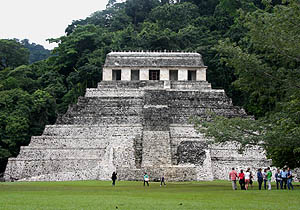
When I arrived in Palenque I spoke to the priest Alberto Gómez Sánchez, better known as Father “Beto”, who manages this house, and he told me: “Looking at the enormous influx of Central Americans who pass by heading North, this church and I feel the empathy for those brothers who pass by in infrahuman conditions.” “There is a truly dramatic situation, especially in Honduras, who was devastated by a tornado, other than the misery the country lives in, the huge political corruption, etcetera. This makes the flow of people continue with no end, because they see no other hope to move their families forward. Many of them already have relatives in the United States and this encourages them to try over and over and over.
Because, of course, when they are detained by Migration Services, other than being stripped of their money, they are returned to the border. If you chat with any of them you will notice that it is not the first time that they are attempting, and they keep struggling to reach that American Dream, which is mostly an illusion, because we already know that the conditions there are very hard. There’s unemployment there as well, but that doesn’t discourage them”.
“Many times we have asked them why they risk so much, why do you leave your family, you know the risk is high. There is a lot of crime in the train where they travel on the roof, organized groups charge them with excessively high fees of 100 USD as right of passage, they are kidnapped, women get raped, there’s even murder. Their answer is always the same: we rather die trying than die starving by staying in our country.”
“The Immigrants House Jtatic Samuel Ruiz García was started with the solidarity of the community, calling out good will people because we have no government fund”. We have over a year with it and in that time we have hosted an average of 100 immigrants per day, to whom we provide food, a place to rest during the day, do laundry, shower and receive kind treatment from the volunteers. Also, there are nuns there who are also nurses and provide healing or medication within our reach.”
Currently, official data point out to the fact that 300,000 people with no documents, in their majority Central Americans, cross through the 1000 km border that Mexico shares with Guatemala and Belize, trying to reach the United States.
In the Caribbean
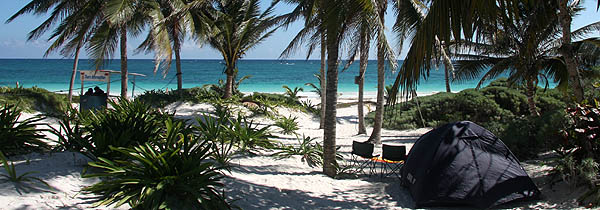
When I arrived to Playa del Carmen, I headed to the Municipal City Hall to request a permit to sell my documentary. After speaking with several people, Harvin Contreras saw me; he is the Sports Institute Director. Then I went to the Mayor Mauricio Góngora Escalante, and lastly to the Treasury Income Director, where I finally got the blessed permit to set up shop on Fifth Avenue, the main street on Playa. For over a month I showcased my bicycle and chatted with every curious person who approached me. During my stay in Playa I sold documentary 1000th and finally, after almost one year of its launch, I have finished paying off the debt to the crew making it.
During my stay in the Mexican Caribbean I noticed that locals were very displeased with the Chinese mega development Dragon Mart, which is already being set up very close to Cancun. After Dubai, Dragon Mart is the second biggest Chinese project in the world, which aims to create the Chinese Product Distribution Center, to distribute all this merchandise throughout Mexico and all of Latin America. Other than the disastrous economic consequences for the national industry, it is believed that Dragon Mart will bring about harsh environmental, social and cultural implications, due to the devastation of the natural resources that the widening of the docks would entail, and the massive Chinese immigrants who would arrive to work there.

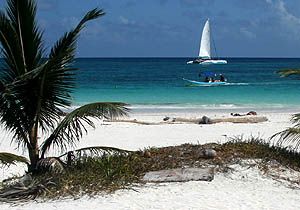
After my stop at Playa del Carmen I enjoyed a couple of weeks in Cancun, Isla Mujeres, Cozumel and Tulum. Sand there is white and fine as talc; the sea is turquoise blue. Just like the beaches of Brazil, Tanzania and Thailand, Mexican Caribbean beaches, as of now, enter mi list of the prettiest in the world. Luckily, I was able to camp at places as Cancun, Isla Mujeres and Tulum, but there were people like Diego and Miriam, who are setting up shop in the Caribbean, as many other Argentine professionals. I also noticed a big flow of Argentine university students, mainly from Cordoba, who travel in the summer and work for 10 or 15 USD a day, although many of them don’t even get that.
Lastly, in Tulum I ran into old Argentine Friends that my travel had given me previously. Leandro had hosted me in Rome and Fran I had met in Australia, during his tour around the world by bike. For the next couple of months, my trip will continue with this rasta from Cordoba who has been 6 years on the road, and Juan, Fran’s friend who is just starting in the cycle-tourism world. Central America awaits.
I want to thank the bicycle stores Viansi and A la Montaña in Mexico City, and Bikezone in Merida for having given me the parts I needed to continue. Also the Tío Rafa hostal in Merida for the free stay and their warm hospitality. And every Mexican that one way or another showed me a friendly hand for me to carry on. I’ve said it: Mexico has marked my trip and my heart.


